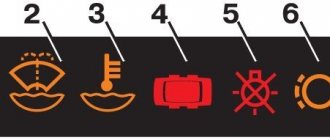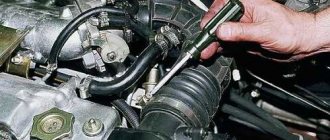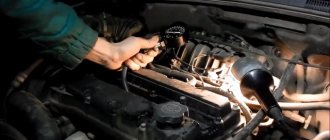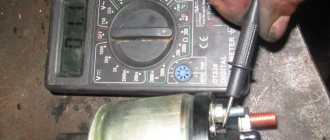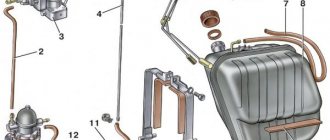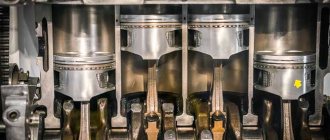You rarely see imported components on domestic cars. Basically, AvtoVAZ engines are equipped with a Solex or Ozone carburetor. Less often you can find products from the Dimitrovgrad Aggregate Plant, known for its reliability: the DAAZ carburetor. Drivers of relatively modern cars, accustomed to the check engine light, can easily determine any malfunction using an on-board computer or an inexpensive car scanner, but for veteran engine owners, only hardware diagnostics are available.
A common malfunction is idle speed floating, the main symptoms are:
- It would seem that the problem does not affect the speed - with intensive use of the gas pedal, the malfunction is invisible. However, it is dangerous in traffic jams, when the engine may suddenly stall, and when engine braking on a long descent;
- In addition, increased vibrations do not add life to the motor and attachments. Bearings of rotating shafts experience axial loads that are not typical for them. And it is uncomfortable for passengers to be in the car when the tachometer needle jumps from 500 to 1500 rpm.
The driver is forced to constantly apply gas, this distracts from the road and increases gas consumption.
So, manifestations of floating idle:
- The tachometer needle moves smoothly or sharply in the range of 1000 revolutions;
- The car shakes noticeably: there is always a feeling that it will stall;
- Pops of unburned fuel in the muffler and under the hood. In the first case, the mixture is rich, in the second, it is lean;
- Vibrations similar to tripping (at the same time you are sure that the spark plugs and the high-voltage part of the ignition system are in good condition);
- The motor randomly picks up speed, then smoothly reduces it. The problem is non-linear, it suddenly appears and also disappears suddenly (this somewhat complicates the diagnosis).
It is not difficult to localize the fault. If (we repeat: in the absence of other malfunctions), the speed fluctuates, look at the carburetor.
Why the speed fluctuates - localization of the fault
First, you need to cut off potential sources of the problem close to the carburetor.
- Let's leave the fuel supply alone. It (gasoline) is either there and the engine is running, or it is not there and there is no problem with idling (as well as the engine itself);
- A potential culprit is a clogged engine air filter. The main cause of uneven idle is air, or rather oxygen, so we inspect the first obstacle in the way of oxygen especially carefully. If you changed the filter at the end of spring, it may be clogged with June poplar fluff. Regular trips on primers, or clouds of dust donated by the “coaters”, coke the pores of the filter element within a month. It happens that a low-quality product from “homemade” ones from the Middle Kingdom simply breaks into shreds and clogs the carburetor throttle assembly with scraps. In any case, let's start by checking the filter;
- The diametrically opposite reason is excess oxygen. The intake tract of an internal combustion engine is relatively sealed. All incoming air flows are carefully calculated by engineers. In injection systems there is a mass air flow sensor, and the ECU can adjust the mixture parameters depending on the oxygen flow. The carburetor has only a mechanical setting for a certain volume. Any unauthorized air leak causes floating speed. The filter breaks, the valve cover gasket breaks, or the carburetor seal leaks - and unaccounted for (and also dirty) air goes into the chamber. The leak can be on the fittings of the vacuum tubes and on the crankcase ventilation system.
A less common cause is the housing or diaphragm of the distributor vacuum regulator. That is, the device responsible for the stable operation of the power unit is itself the cause of the malfunction.
If none of the listed reasons are found, we will inspect the carburetor. Moreover, no special equipment, much less electronic devices, is required.
VAZ 2110, 11, 12. Why does the idle speed disappear?
Hello. Today I continue a series of articles about engine management system malfunctions associated with injection wiring problems. Using the example of cars of the VAZ 2110, 11, 12 family.
Models VAZ 2110, 11, 12 are frequent guests in car service centers, because... the years take their toll. The cause of breakdowns associated with the engine management system is often injection wiring.
The following problem arises: on a warm engine, when the fan turns on at idle, the speed starts to rise to 600-800 rpm or the engine may stall completely.
When checking with diagnostic equipment, the use of actuator controls is very informative. With the ignition on and the engine off, forcefully turn on the fan in the diagnostic program menu. At the moment of switching on, the voltage drop in the ADC channel of the mass air flow sensor occurs. The voltage drops from 0.996 Volts to 0.967 Volts (in my case, otherwise the signal can drop even lower).
In this case, the problem also lies in the injection wiring. Inside the car, the wiring masses of the engine control system are screwed to a metal bracket on which the electronic engine control unit is located. The negative voltage from the body is transmitted to these ground wires through the bracket mount. Over time, the tightening of the nut loosens and, one might say, a partial loss of mass occurs.
Methodology for finding problems on domestic carburetor systems
Before you start troubleshooting, you need to check that the carburetor is adjusted correctly. The manufacturer sets the settings for ideal operating conditions - the amount of oxygen in the atmosphere of flat terrain and gasoline that complies with GOST. And this is on a new car.
In reality, periodic adjustment of all 4-5 carburetor adjustment screws is required. At least two of them are responsible for stable idle operation. The adjustment is made with the engine running using a simple screwdriver.
The procedure is described in the owner's manual, and differs slightly depending on the carburetor model. The main condition for correct tuning is the absence of leaks, a clean air filter, and high-quality gasoline. The amount of oxygen in the air corresponds to daily use. That is, if you live on a plain, there is no point in adjusting the carburetor while climbing a mountain serpentine to an altitude of 800 meters above sea level.
- Warm up the engine to a temperature of 90°C. If there is no thermometer, the degree of heating can be easily determined by the opening of the cooling system thermostat;
- We start the engine, give a small load - turn on the headlights and the climate system (without air conditioning). Each type of carburetor has its own idle speed, let’s take 750-800 rpm as a basis, as on Solex. The idle speed is controlled by the “quantity” and “quality” screws of the mixture. It will not be possible to establish normal speed with wine alone;
- The forced choke lever (choke) is closed;
- Using the “quality” screw, we adjust the speed to the maximum possible value. As a rule, the screw is fixed at the factory and closed with a plug. It needs to be removed;
- Next, using a standard (on the dashboard) or remote tachometer, set the speed to 900, turning only the “quantity” screw;
- Then use the “quality” screw to set the required value: 750-800 rpm.
Afterwards, you need to start the engine in normal mode, make a test drive, and accelerate in neutral several times to the maximum speed. Then turn off the engine, and after a couple of minutes start it again and check the number of revolutions at idle with a load (high beam + heater). If necessary, repeat the adjustment process.
The main reasons for engine stalling at idle
Before we begin to describe the main reasons why the engine stalls at idle, it is worth saying a few words about how this happens. You get into the car and start the engine, which functions as usual. But as soon as you take your foot off the gas pedal, a drop in revolutions is observed, although the idle speed sensor shows the nominal speed. At the same time, you can clearly hear that the engine is operating unstably, or even stalls completely. This is manifested by detonation of the propulsion system, which can cause very unpleasant complications.
It should be noted that when you start the engine again, the problem may not appear, and you can easily hit the road, but after a while the engine will stall again. That is why, after discovering the first malfunctions, you should immediately begin troubleshooting.
Almost every car owner has experienced engine stalling.
However, first of all, it is worth determining what exactly may be causing the incorrect operation of the power plant. As a rule, car owners and auto mechanics agree on the following main reasons why the engine may stall at idle:
- malfunction of the idle speed sensor or its complete failure;
- accumulation of dirt in the throttle valve;
- failure of the throttle position sensor;
- contamination of the carburetor or injector (depending on the type of car).
Of course, in some cases the problem may be more trivial: a misaligned battery terminal, an empty fuel tank, the use of low-quality fuel, etc. But we will not focus on them, since even an amateur car owner can solve these problems.
The causes of the malfunction in each individual case may differ radically, so you must be prepared to use various measures to eliminate them. As practice shows, experienced car owners are able to cope with the problem on their own, while beginners are better off immediately seeking the help of specialists.
The carburetor is adjusted, there are no other faults, but your engine speed still fluctuates
Next comes the search for real carburetor faults.
- Checking the idle speed solenoid valve. If you briefly apply power to it (by resetting and replacing the connector), you should hear a characteristic click. A faulty valve must be replaced;
- The float chamber needle valve is stuck. You will have to disassemble and wash the carburetor. If this does not help, the valve is replaced with a new one; it is impossible to sharpen or restore it at home;
- The idle passages or jets are clogged with debris. Flushing is required, preferably with the carburetor removed. A special detergent (such as “carbcleaner”) is used, then the channels are blown out with compressed air. A compressor will not work; it is better to use an inflated spare tire and a blow gun.
By and large, there are no other reasons for a floating idle associated with the carburetor. If after carrying out the above procedures, the problem remains, then this is a banal problem, with its own symptoms and causes.
The mechanical system for forming the fuel mixture requires literally surgical cleanliness of the internal components. Neglect of timely replacement of filters, as well as saving on matches (the cheapest gasoline in the area), lead to regular problems with the engine. However, eliminating them is not difficult - all you need is a simple tool and a steady hand.
If you have any questions, leave them in the comments below the article. We or our visitors will be happy to answer them
Problems with classic and front-wheel drive Lada cars
On such cars, the engine often stalls at idle. If the engine is carburetor, then this is usually the problem. It may be clogged, or the idle jet, which is responsible for the normal operation of the engine at idle, is clogged.
You need to pull out the jet and blow it out, then rinse it with solvent. If this does not help, then you can check the solenoid valve.
To control it, you need to turn on the ignition and disconnect the wire from it. Then connect again. A click should be heard. If it is not there, then you need to measure the voltage on this wire. If the control lamp is on, the valve must be replaced. If it is not possible to purchase a valve, then you can still go a long way if you use a simple method. The valve needle just needs to be broken off. At the same time, fuel consumption will increase slightly, but you will get to your destination.
Injector Lada cars have similar faults: sensor failure. Occasionally, an electronic unit breaks down, which can be found at a repair shop.
Lost idle speed on injection engine, reasons
A list of the main, most common reasons for the appearance of unstable idle speed or their complete disappearance on injection engines (2111) of VAZ 21083, 21093, 21099 cars.
All malfunctions are grouped by engine systems: ignition system, power system, control system (ECM), engine engine. Most of them are easily determined using diagnostic equipment, but faults can be found without it.
Before identifying a malfunction, it is necessary to carry out a visual inspection of the engine compartment (elements of the ignition system, sensors, tubes, hoses), check the tightness of the contacts in the connecting blocks, the tips of high-voltage wires in the ignition coil and spark plugs.
Causes of unstable idling of an injection engine related to the ignition system
— Spark plugs are faulty
Faulty spark plugs: flooded after an unsuccessful start, the insulator is “broken,” the gap between the electrodes does not correspond to the norm (0.9 – 1.1 mm), the spark plugs do not match the engine’s heat rating. External signs: unstable idling, uneven exhaust from the muffler (periodic or frequent misfires). It is necessary to blow out the spark plugs: press the gas pedal all the way down and crank the engine with the starter for several seconds (the so-called purge mode). Having turned them out, evaluate the condition of the contacts, the presence and color of carbon deposits, and check the gap with a round feeler gauge. Non-working spark plugs are often clogged with carbon deposits or wet. But in some cases it is impossible to determine their malfunction visually, so the easiest way is to install a new kit and check the engine idling again.
— High-voltage wires are “broken”
External signs are similar to candlesticks. You can check the serviceability of the wires with a tester in ohmmeter mode. You can start the engine in the dark and observe the glow on the “broken” wires. In addition, it is necessary to visually verify the integrity of the wires and their tips, the absence of dirt and cracks on them.
Measuring the resistance of high-voltage wires
— The ignition coil (module) is faulty
First, we inspect the coil: check for cracks and damage. Then we check it with a tester in ohmmeter mode (See “Checking the ignition module”). We replace the one that does not pass the test with a serviceable one.
Malfunctions related to the engine control system (ECM)
— Idle speed regulator (sensor) (IAC) is faulty
The rod of a faulty regulator may not timely close the air supply channel necessary for engine operation at idle under the throttle valve. Signs of a faulty regulator, in addition to unstable idling: starting the engine by pressing the gas pedal, jerks and drops in speed when changing gears and coasting, “floating” speed, idling sometimes, sometimes not, drop in speed when powerful electrical consumers are turned on. At the same time, in other modes with the gas pedal pressed, the engine can operate normally without failures, jerking or jerking. The sensor can be checked with a tester or replaced with a known good one (by adjusting the protrusion of its needle).
— Throttle position sensor (TPS) is faulty
A faulty TPS may provide the control unit with incorrect information about the throttle position. As a result, at idle speed the engine speed may increase greatly and be reluctant to decrease to normal or not decrease at all. The TPS can be checked with a tester or replaced with a working one.


